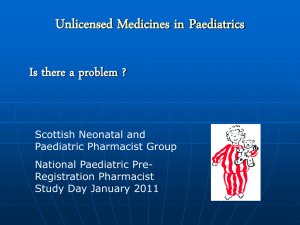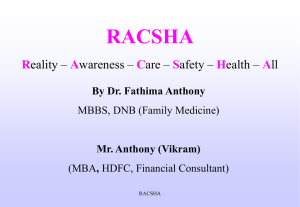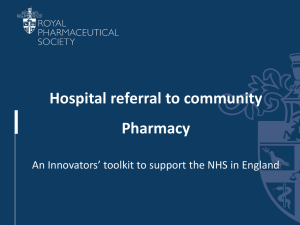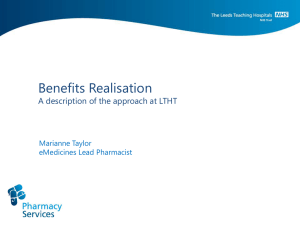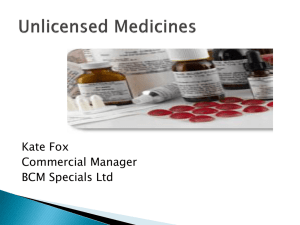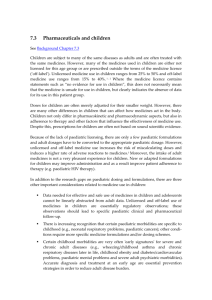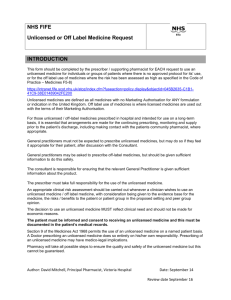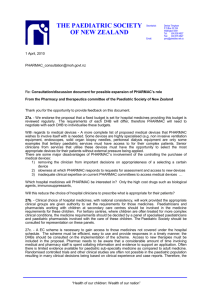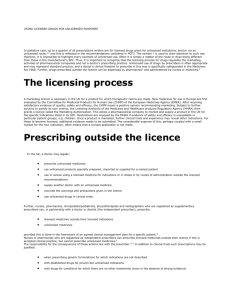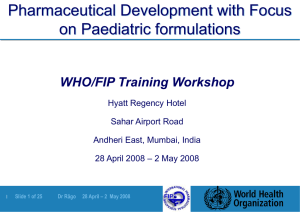Paediatric Prescriptions
advertisement
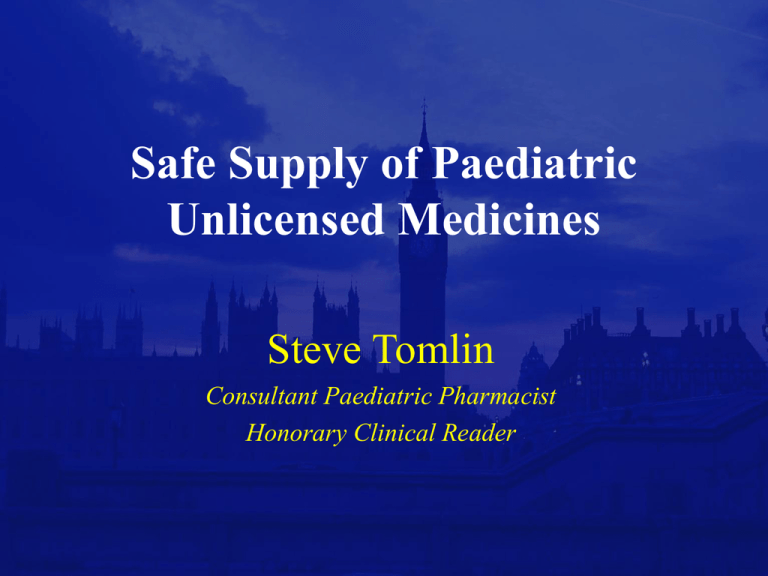
Safe Supply of Paediatric Unlicensed Medicines Steve Tomlin Consultant Paediatric Pharmacist Honorary Clinical Reader Every Dose Is Different • Is dosing in adults logical? – One size fits all – useful for tablets • Paracetamol, ranitidine • When does a child become an adult? • Mg/kg • When can doses be rounded up or down? • Paracetamol, cefuroxime • Is Licensing Logical? • Aciclovir What do children take? Dose (mg) 30 60 120 250 500 Dosage form? Drops Liquid/melt Liquid/melt Liquid/melt/ tablet Tablet/ capsule Therapeutic Orphans • Europe - >50% of medicines used in children have never been tested in children. • Conroy S, Br Med J. 2000, 320:79-82 • Australia - 25% of medicines licensed in children do not have appropriate formulations for children. • Tan E, Med J Aust. 2003, 179(4):195-8 • 1/3 of research papers into children’s medicines did not allow for the work to be reproduced / 51% did not use a paediatric formulation. • Standing J, Paediatrics. 2005, 116(4):559-562 • Pandit S, Arch Dis Child. 2010, 95:754-756 Unlicensed & Off-Label Medication Proportion of medicines used not licensed: 80% Neonatal Intensive Care Unit (NICU) 40% Paediatric Intensive Care (PICU) 25% general paediatric in-patients 11% children at home Nunn A, 2003, Arch Dis Child. 2003. 88:369-371 Policy statement Joint RCPCH/NPPG Standing Committee on Medicines • ‘it is not necessary to take additional steps, beyond those taken when prescribing licensed medicines, to obtain the consent of parents, carers and child patients to prescribe or administer unlicensed medicines or licensed medicines for unlicensed applications.’ • Treatment Should Be The Best You Can Give! Paediatric Patient Needs • Age-appropriate formulations – Type of formulation (liquid / solid) – Dose flexibility – Excipients and levels • Ease of dosing and compliance – – – – Palatability Frequency of dosing Ease of manipulation (by carer) Perceptions of parent / carer? What medicine are you getting? • • • • • Licensed In Some Children Licensed Adult Medicine Import Special Extemporaneously Prepared • Product aligned to Clinical Need Intravenous Preparations • Hospital Neonatal Unit – 31% of prescriptions < 1/10 vial – 4.8% of prescriptions <1/100 vial • Arch Dis Child. 2000; 834:92-6 • Dose calculations often involve decimal points • Units often have to change – how to label • Standard Concentrations IV Formulation – Benzyl alcohol harmful in infants • contained in e.g. amiodarone and lorazepam injections – Shehab N, Pediatr Crit Care Med. 2009. 10(2): 256-259 – Phenobarbital injection – 90% propylene glycol hyperosmolality in infants, pH 11 – Ibuprofen – lignocaine in premature babies – Paracetamol – 10 x overdoses – Phenytoin – need to dilute, but it precipitates Oral Formulations – Phenobarbital elixir BP – 38% alcohol – Sugar or Sorbitol? – Dispersible Tablets (aspirin and diclofenac) – The history of nifedipine – Tuleu C, J of Drug Delivery Science & Tech. 2005. 15(4): 319-324 – Captopril – bioequivalence? – Mulla H, Arch Dis Child. 2007. 92:409-411 – Clobazam – what’s left in the bottle – Glass ampoules for oral solutions? – (vitamin K, Caffeine) Import/export of captopril oral liquid 10578 miles each way BMS, UK No MA for children Not bioequivalent to: tablets compounded liquids BMS, Victoria, Australia Changing Medicines • Crushing tablets can change profile 165 – Increase side effects – Decrease duration 110 55 0 0 4 8 12 16 20 24 0 4 8 12 16 20 24 165 110 55 0 Pharmaceutical Issues when Crushing, Opening or Splitting Oral Dosage Forms June 2011 • Changing the way in which a dosage form is presented can alter its absorption characteristics, result in medicines instability, produce local irritant effects, cause failure to reach the site of action, may produce occupational health and safety issues, and could result in a preparation with an unacceptable taste. • .. In most circumstances in which no appropriate licensed medicine is available, the prime objective should be to provide patients with a ready-to-use unlicensed medicine. Other Routes • INTRANASAL – Midazolam – why do they cry? • TOPICAL – Chlorhexidine – it just cleans the skin!! • RECTAL – Glycerine Chips – Paracetamol / Morphine The Future • • • • • Standardisation / Formulary BP? BNF-C? Directed Prescribing Defined Drop down boxes Tighter Tariff
